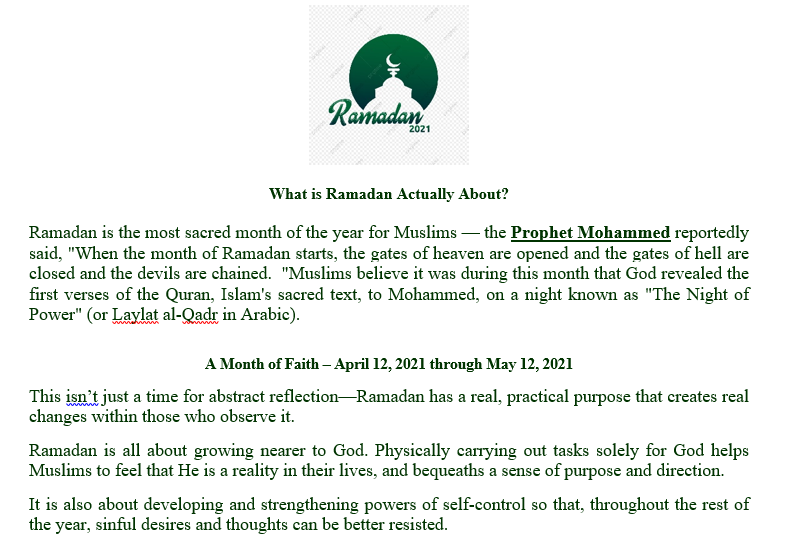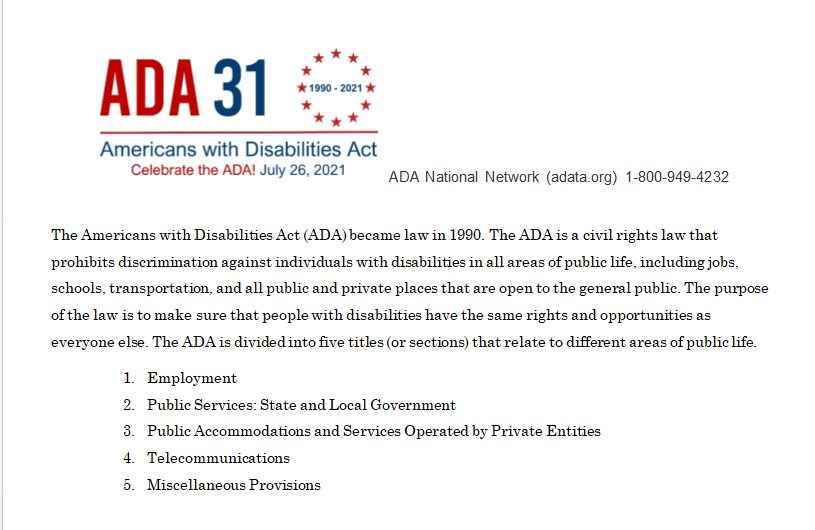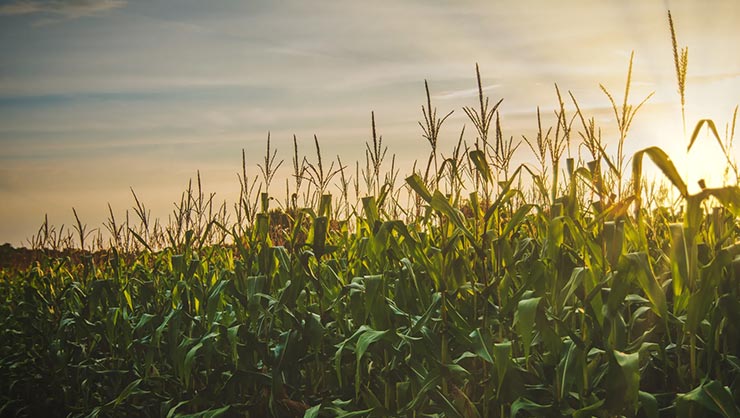
Celebrating Holidays & Awareness Days
The DEI Committee has a Holiday Awareness Sub-Committee that provides staff with descriptions of various holiday celebrations. This Sub-Committee also shares information about National Awareness Days.
Below are some examples of presentations and resources shared by this Sub-Committee.
Passover - March or April
Holi - March 28-29
Reconciliation Day - April
May - Many celebrations... watch below
Jewish American Heritage Month - May
- https://youtu.be/KWHwm7V80uo Influence of Jewish Family
- https://youtu.be/v9BAtn_9X7Q On how Jewish American Heritage Month was enacted.
- https://youtu.be/Kg27nyWaKAc depicts the history of Jewish American Women
- https://www.archives.gov/news/topics/jewish-american-heritage
- https://www.youtube.com/user/ushmm
Ramadan - April 12 - May 12

https://www.vox.com/2017/5/25/11851766/what-is-ramadan-2021-start-date-muslim-islam-about
Pride Month - June
Pride Month is celebrated every June in tribute to those involved in the Stonewall Riots, and we’re getting ready to dust off our rainbow flags and join in the fun. With parades, festivals and concerts going on across the globe, there’s always some way for you to get involved — as well as learn some important social history along the way.
LGBTQ+ Milestones in History:
- 1946 - The First LGBT Organization: The Netherlands Center for Culture adopts a vague name to mask its then taboo purpose.
- 1968 June 25th – The First Rainbow Flag Flies High: Gilbert Baker's original design of the rainbow gay pride flag is flown at the San Francisco Gay Freedom Day Parade.
- 1969 June 28th – The Stonewall Riots: NYC police raid the Stonewall Inn, instigating the Stonewall Riots.
- 1970 June 20th – The First Pride Parade: Organized by pioneering bisexual activist Brenda Howard and a committee she put together, the parade sees supporters march from Greenwich Village to Central Park.
- 2016, June 26th – Same Sex Marriage Rights: The U.S. Supreme Court makes same-sex marriages legal in all 50 U.S. states.
Want to Learn More? Check out these videos and websites!
- https://youtu.be/zWvLJNaVgrI Finding Identity: An LGBTQ Pastor’s Journey | David Norse | TEDxPhiladelphia
- https://www.youtube.com/watch?v=ivfJJh9y1UI This Is What LGBT Life Is Like Around the World | Jenni Chang and Lisa Dazols | TED Talks
- https://www.youtube.com/watch?v=ZKU70lAJbEU PBS NewsHour LGBTQ asylum seekers persecuted at home and in U.S. custody
PRIDE Resources:
- https://www.hrc.org/press-releases/2021-slated-to-become-worst-year-for-lgbtq-state-legislative-attacks More than 250 anti-LGBTQ bills have been introduced in state legislatures across the country in 2021, and additional bills may be filed before the end of the legislative sessions.
- https://nationaltoday.com/pride-month/#how-to
- https://www.nami.org/Your-Journey/Identity-and-Cultural-Dimensions/LGBTQI According to a 2013 survey, 40% of LGBT adults have experienced rejection from a family member or a close friend. A 2019 school climate survey showed that 86% of LGBTQ youth reported being harassed or assaulted at school, which can significantly impact their mental health.
- https://gaycenter.org/
- https://www.hrw.org/topic/lgbt-rights
- https://prideri.org/about/ Out of an abundance of caution, Rhode Island Pride organizers elected to suspend Rhode Island PrideFest and the Illuminated Night Parade due to the COVID-19 pandemic.
- https://www.facebook.com/PrideRI/
- https://www.lgbtasylumproject.org/ The LGBTQ Asylum Project
Americans with Disabilities - July 26

Nelson Mandela International Day - July 18
On July 18th every year, we invite you to mark Nelson Mandela International Day by making a difference in your communities. Everyone has the ability and the responsibility to change the world for the better! Mandela Day is an occasion for all to take action and inspire change.
How did the day come about?
On November 2009, in recognition of the former South African President’s contribution to the culture of peace and freedom, UN General Assembly declares 18 July "Nelson Mandela International Day". Resolution A/RES/64/13 recognizes Mandela’s values and his dedication to the service of humanity in: conflict resolution; race relations; promotion and protection of human rights; reconciliation; gender equality and the rights of children and other vulnerable groups; the fight against poverty; the promotion of social justice. The resolution acknowledges his contribution to the struggle for democracy internationally and the promotion of a culture of peace throughout the world.
- Dozens of modern-day pagans, druids, and others visit Stonehenge during the solstice to pay homage to the return or rebirth of the sun. They play music and dance or perform other activities in order to welcome the sun back.
-
Newgrange is a burial mound in Ireland’s Boyne Valley which is thought to be over 5,000 years old, and it contains a passage that is aligned to the sun. Every year, thousands apply to see the first rays of the sun filling the chamber. Only around 60 people get to do it.
-
Pagans also celebrate yule with several days of feasting and gift-giving, culminating in Winter Solstice Day, the central celebration. They use sacred colors, red, green, and white, and evergreens to decorate their homes. They honor such ancient gods and goddesses as Cronos (Father Time), by lighting candles, burning circle fires outside and yule logs indoors.
-
In different parts of Asia, people celebrate the solstice, known by such names as Dongzhi or Dongji, by giving gifts and eating special dishes. E.g. The Koreans eat a red bean porridge to repel evil spirits; the Chinese eat balls of rice in a broth.
-
In Japan, people soak in fruit-filled baths to welcome the sun and protect themselves from catching a cold during the winter.
-
In Austria, crowds of revelers go to town squares to see and be teased by Krampus, the half-demon, half-goat equivalent to Santa Claus.
-
In Iran, friends, and family get together for the solstice, Yalda night, and eat dinner, read significant poetry and eat symbolic fruit, such as pomegranates, which represent the dawn of life.
- In the Middle Ages, Christmas celebrations were rowdy and raucous—a lot like today’s Mardi Gras parties.
- When Christmas was cancelled: From 1659 to 1681, the celebration of Christmas was outlawed in Boston, and law-breakers were fined five shillings.
- Christmas was declared a federal holiday in the United States on June 26, 1870.
- The first eggnog made in the United States was consumed in Captain John Smith’s 1607 Jamestown settlement.
- Poinsettia plants are named after Joel R. Poinsett, an American minister to Mexico, who brought the red-and-green plant from Mexico to America in 1828.
- The Salvation Army has been sending Santa Claus-clad donation collectors into the streets since the 1890s.
- Rudolph, “the most famous reindeer of all,” was the product of Robert L. May’s imagination in 1939. The copywriter wrote a poem about the reindeer to help lure customers into the Montgomery Ward department store.
- Construction workers started the Rockefeller Center Christmas tree tradition in 1931.
1. Umoja: Unity - To strive for and maintain unity in the family, community, nation, and race.

2. Kujichagulia: Self-Determination - To define ourselves, name ourselves, create for ourselves, and speak for ourselves.

3. Ujima: Collective Work and Responsibility - To build and maintain our community together and make our brothers' and sisters' problems our problems and solve them together.

4. Ujamaa: Cooperative Economics - To build and maintain our own stores, shops, and other businesses and to profit from them together.

5. Nia: Purpose - To make our collective vocation the building and developing of our community in order to restore our people to their traditional greatness.
6. Kuumba: Creativity - To always do as much as we can, in the way we can, in order to leave our community more beautiful and beneficial than we inherited it.

7. Imani: Faith - To believe with all our heart in our people, our parents, our teachers, our leaders, and the righteousness and victory of our struggle.

1. Mazao: Crops - Mazao symbolizes the fruits of collective planning and work, and the resulting joy, sharing, unity and thanksgiving part of African harvest festivals. To demonstrate mazao, people place nuts, fruits, and vegetables, representing work, on the mkeka.
 Image courtesy of Pexels
Image courtesy of Pexels
2. Mkeka: Place Mat - Just as the crops stand on the mkeka, the present day stands on the past. The mkeka symbolizes the historical and traditional foundation for people to stand on and build their lives.

A mkeka mat from Tanzania.Image courtesy of Wikimedia Commons
3. Muhindi: Ear of Corn - The stalk of corn represents fertility and the idea that through children, the future hopes of the family are brought to life. One vibunzi is placed on the mat for every child in the family.
 Image courtesy of Pexels
Image courtesy of Pexels
4. Mishumaa Saba: The Seven Candles - Candles are ceremonial objects that serve to symbolically re-create the sun’s power, as well as to provide light. There are three red candles, three green candles, and one black candle that are placed on the kinara.
 Image courtesy of Wikimedia Commons
Image courtesy of Wikimedia Commons
5. Kinara: The Candleholder - The kinara represents our ancestry, and the original stalk from which we came.
 Image courtesy of Wikimedia Commons
Image courtesy of Wikimedia Commons
6. Kikombe Cha Umoja: The Unity Cup - On the sixth day of Kwanzaa, the libation ritual is performed to honor the ancestors. Every family member and guest will take a drink together as a sign of unity and remembrance.
 Image courtesy of Wikimedia Commons
Image courtesy of Wikimedia Commons
7. Zawadi: Gifts - On the seventh day of Kwanzaa, gifts are given to encourage growth, achievement, and success. Handmade gifts are encouraged to promote self-determination, purpose, and creativity.
Above all, Kwanzaa is a time for family and love.